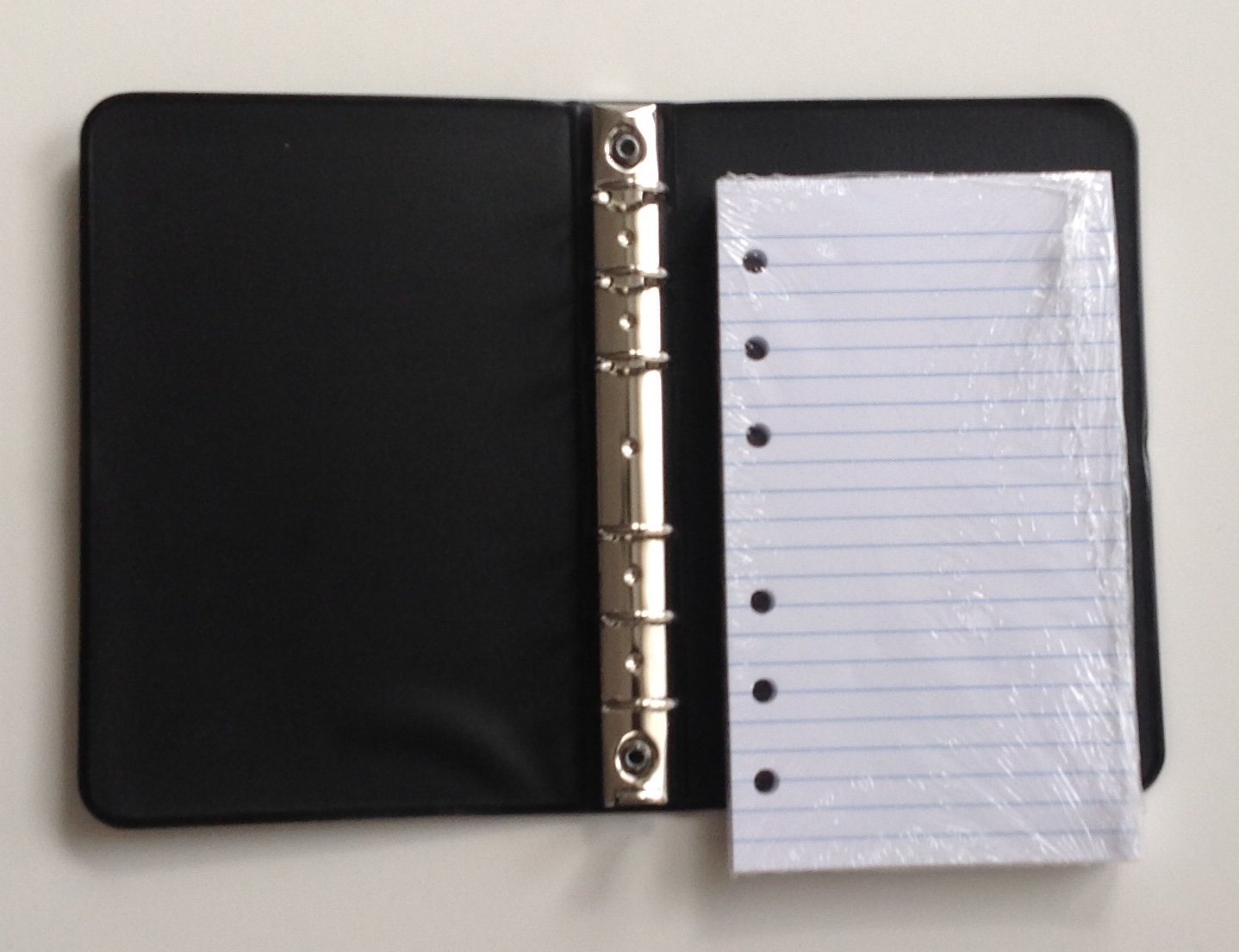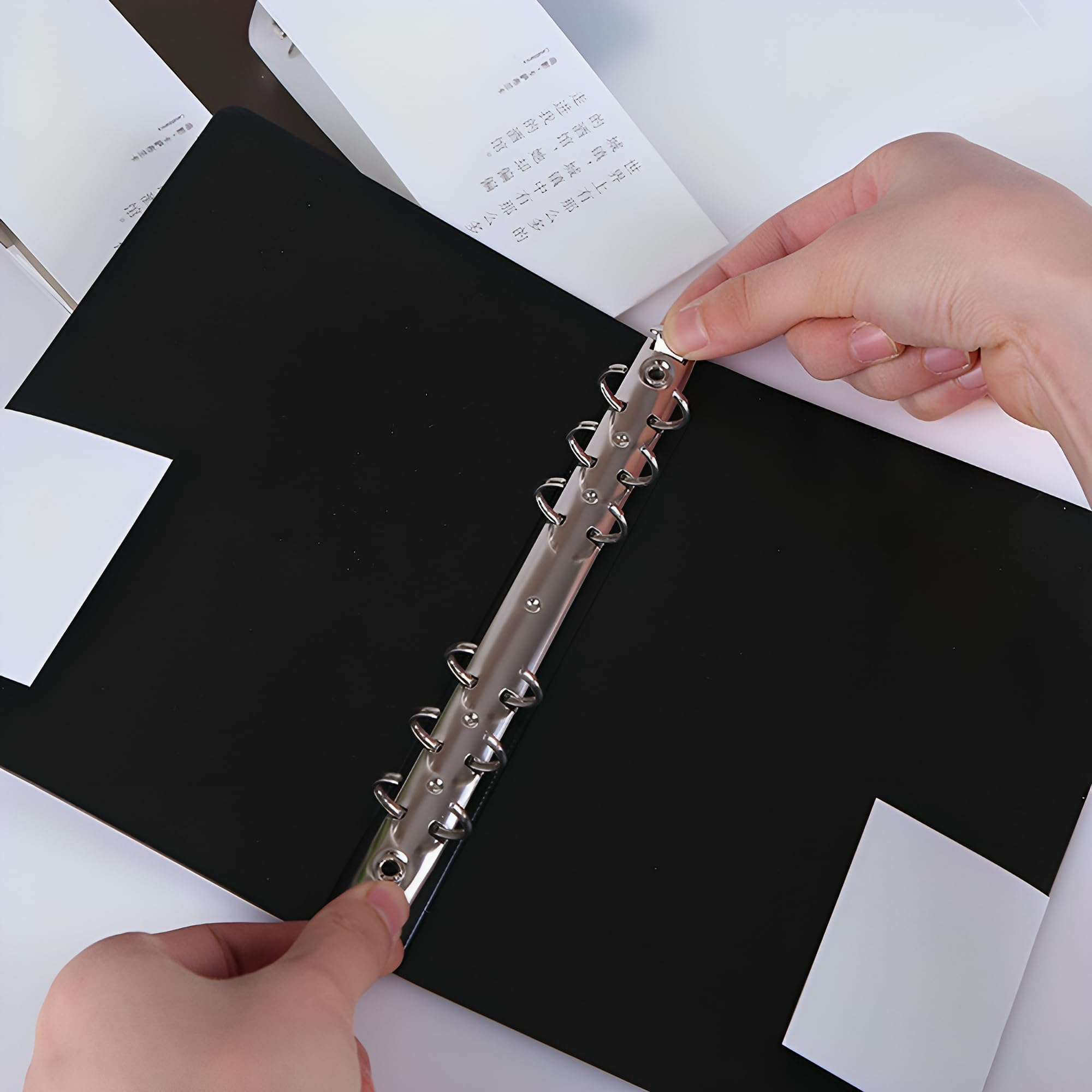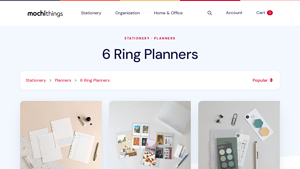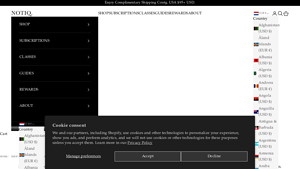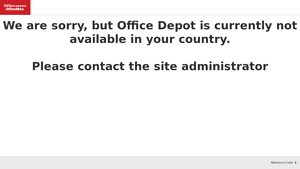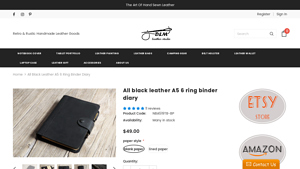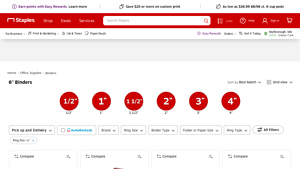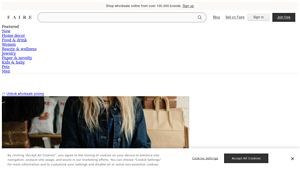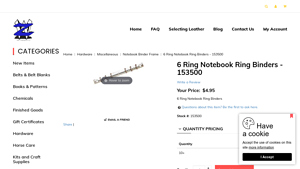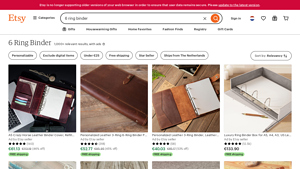Everything You Need to Know About 6 Ring Binders Sourcing in 2025
Introduction: Navigating the Global Market for 6 ring binders
In the ever-evolving landscape of office supplies, sourcing high-quality 6 ring binders presents a unique challenge for international B2B buyers. Whether you’re based in Africa, South America, the Middle East, or Europe, the need for effective organizational tools that cater to diverse business needs is paramount. This guide aims to equip you with the knowledge necessary to navigate the global market for 6 ring binders, focusing on various types, applications, and features that can enhance operational efficiency.
Understanding the nuances of 6 ring binders—from material selection to size variations—can significantly impact your purchasing decisions. We’ll delve into the different styles available, including customizable options that meet specific branding needs, and explore how these products are utilized across various industries. Additionally, this guide will outline best practices for vetting suppliers, ensuring quality control, and evaluating costs to maximize your investment.
By providing actionable insights and comprehensive information, this resource empowers international B2B buyers to make informed choices that align with their organizational goals. Whether you’re seeking durable binders for educational institutions or elegant options for corporate presentations, our guide will help streamline your sourcing process and elevate your brand’s professional image in a competitive marketplace.
Understanding 6 ring binders Types and Variations
| Type Name | Key Distinguishing Features | Primary B2B Applications | Brief Pros & Cons for Buyers |
|---|---|---|---|
| A5 Leather Binders | Premium leather finish, customizable inserts | Executive gifts, high-end presentations | Pros: Durable, professional appearance. Cons: Higher cost. |
| Plastic 6 Ring Binders | Lightweight, waterproof, and available in various colors | Schools, warehouses, and general office use | Pros: Cost-effective, versatile. Cons: Less durable than leather. |
| Zippered Binders | Enclosed design with pockets for secure storage | Travel, project management, and events | Pros: Secure, organized. Cons: Bulkier to carry. |
| Photo Pocket Binders | Designed with transparent pockets for photos/documents | Marketing, portfolio presentations | Pros: Great for visuals, easy access. Cons: Limited document capacity. |
| Planner Binders | Includes pre-printed planner pages and customizable options | Personal organization, project tracking | Pros: Structured planning, customizable. Cons: May require frequent refills. |
What are A5 Leather Binders and Their B2B Suitability?
A5 leather binders are characterized by their high-quality leather construction and elegant design, making them suitable for executive gifts and high-stakes presentations. Their customizable inserts allow businesses to tailor the binder to specific needs, enhancing brand visibility. When purchasing, consider the durability of the leather and the customization options available, as these factors can significantly impact the binder’s longevity and presentation appeal.
How Do Plastic 6 Ring Binders Serve Various Industries?
Plastic 6 ring binders are lightweight and waterproof, available in a wide range of colors and sizes. They are commonly used in educational institutions, warehouses, and general office settings due to their cost-effectiveness and versatility. Buyers should evaluate the thickness of the plastic and the ease of customization, as these aspects affect the binder’s functionality and visual appeal in a professional context.
What Advantages Do Zippered Binders Offer for Business Use?
Zippered binders feature a secure enclosure and multiple pockets for organizing documents, making them ideal for travel, project management, and events. They provide a secure way to transport important materials, ensuring nothing is lost. However, their bulkier design may not be suitable for all users, so businesses should weigh the need for security against portability when making a purchase decision.
Why Choose Photo Pocket Binders for Marketing and Presentations?
Photo pocket binders are specifically designed with transparent pockets that allow for easy display of photos and documents. They are particularly effective in marketing and portfolio presentations, as they facilitate quick access to visual materials. When selecting a photo pocket binder, consider the number of pockets and the overall capacity to ensure it meets your presentation needs while maintaining a professional look.
What Makes Planner Binders Essential for Personal Organization?
Planner binders come equipped with pre-printed pages for scheduling and organization, making them ideal for personal use and project tracking. Their customizable nature allows users to adapt the binder to their specific planning requirements. When purchasing planner binders, businesses should consider the range of refill options available, as this will impact the binder’s usability and longevity in daily operations.
Key Industrial Applications of 6 ring binders
| Industry/Sector | Specific Application of 6 Ring Binders | Value/Benefit for the Business | Key Sourcing Considerations for this Application |
|---|---|---|---|
| Education | Curriculum organization and student portfolios | Enhanced management of educational materials and easy access for students and educators | Durability, customization options, and compatibility with various refill inserts |
| Corporate & Professional | Project management and client presentations | Improved organization of documents, facilitating better communication and project tracking | Aesthetic appeal, size options, and compatibility with digital tools |
| Healthcare | Patient records and treatment plans | Streamlined documentation and easy retrieval of patient information, enhancing care delivery | Compliance with healthcare regulations and ease of sanitization |
| Legal | Case files and legal documentation | Efficient organization of critical documents, improving case management and client consultations | Security features, customization for specific legal requirements, and durability |
| Creative Industries | Art portfolios and project proposals | Effective presentation of creative work, fostering client engagement and collaboration | Customization for unique designs and materials, as well as size versatility |
How Are 6 Ring Binders Used in the Education Sector?
In the education sector, 6 ring binders are essential for organizing curricula and managing student portfolios. They allow teachers to maintain structured lesson plans and provide students with a way to keep track of assignments and projects. This organization helps in improving academic performance by making educational materials easily accessible. For international buyers, sourcing binders that are durable and customizable is crucial, as they may need to adapt to various educational standards and preferences in different regions.
What Role Do 6 Ring Binders Play in Corporate and Professional Settings?
In corporate environments, 6 ring binders serve as effective tools for project management and client presentations. They help organize essential documents, such as proposals, reports, and meeting notes, ensuring that teams can communicate effectively and track project progress. Buyers in this sector should consider the aesthetic appeal and size options of binders, as these factors can influence professional image and client perception. Furthermore, compatibility with digital tools can enhance productivity.
How Are 6 Ring Binders Beneficial in Healthcare?
In the healthcare industry, 6 ring binders are utilized for organizing patient records and treatment plans. This application ensures that healthcare providers can quickly access critical information, leading to improved patient care and streamlined documentation processes. International buyers must pay attention to compliance with healthcare regulations when sourcing binders, as well as their ability to withstand sanitization processes, given the importance of hygiene in medical settings.
Why Are 6 Ring Binders Important for Legal Professionals?
Legal professionals rely on 6 ring binders to manage case files and legal documentation efficiently. These binders facilitate the organization of critical documents, improving case management and client consultations. For B2B buyers in the legal sector, security features and customization options are paramount, as they may need to tailor binders to specific legal requirements. Additionally, durability is essential to withstand the frequent handling of documents.
How Do Creative Industries Benefit from Using 6 Ring Binders?
In creative industries, 6 ring binders are used to create art portfolios and project proposals. They provide a structured way to present creative work, fostering engagement and collaboration with clients. Buyers in this sector should seek binders that offer customization for unique designs and materials, as well as versatile sizing options to accommodate various types of artwork or project documentation. This flexibility can enhance the overall presentation and effectiveness of creative proposals.
3 Common User Pain Points for ‘6 ring binders’ & Their Solutions
Scenario 1: Difficulty in Customization for Diverse Needs
The Problem: B2B buyers often face challenges in finding 6 ring binders that can be customized to meet varying organizational needs. Many businesses require binders that not only accommodate different sizes of documents but also allow for personalized branding, such as logos and specific colors. This lack of flexibility can lead to frustration, as standard options may not fit the unique requirements of their operations, affecting both functionality and brand representation.
The Solution: To effectively source customizable 6 ring binders, buyers should engage with suppliers that specialize in bespoke solutions. When evaluating potential vendors, inquire about their capabilities for customization, such as material options, sizes, colors, and the ability to print logos or designs. Additionally, consider ordering samples before placing bulk orders to assess the quality and ensure they meet your specifications. Establishing a close relationship with a supplier who understands your business’s unique needs can lead to tailored solutions that enhance productivity and brand image.
Scenario 2: Inadequate Durability for Heavy Use
The Problem: Many businesses require binders that can withstand daily wear and tear, especially in fast-paced environments like offices or educational institutions. Standard 6 ring binders often struggle with durability, leading to issues such as broken rings or frayed edges. This not only disrupts workflow but also necessitates frequent replacements, leading to increased costs and administrative burdens.
The Solution: To combat durability issues, B2B buyers should look for 6 ring binders made from high-quality materials such as reinforced plastic or leather. When selecting binders, pay attention to the construction details, such as the strength of the rings and the overall binding mechanism. Additionally, consider purchasing from reputable manufacturers known for their rigorous quality control processes. Investing in higher-quality binders may incur a higher upfront cost but will ultimately result in savings by reducing the need for replacements and minimizing disruptions to operations.
Scenario 3: Limited Availability of Compatible Inserts and Accessories
The Problem: Another common challenge for B2B buyers is the limited availability of compatible inserts and accessories for 6 ring binders. Businesses often require additional items such as dividers, pockets, and refill pages to enhance organization and functionality. When these accessories are not readily available, it can lead to inefficiencies and frustration in maintaining organized documentation.
The Solution: Buyers should prioritize sourcing 6 ring binders from suppliers that offer a wide range of compatible accessories. Before finalizing a purchase, research the availability of various inserts and accessories that can complement the binders. Additionally, consider establishing a partnership with suppliers that offer complete solutions, including binders, inserts, and organizational tools, to streamline procurement processes. This approach not only ensures that all necessary components are readily available but also helps maintain a cohesive system for document management, ultimately enhancing operational efficiency.
Strategic Material Selection Guide for 6 ring binders
When selecting materials for 6 ring binders, international B2B buyers must consider various factors that impact performance, durability, and cost. This guide analyzes four common materials used in the production of 6 ring binders, focusing on their properties, advantages, disadvantages, and implications for specific markets, particularly in Africa, South America, the Middle East, and Europe.
What are the Key Properties of Plastic for 6 Ring Binders?
Plastic, particularly polypropylene and PVC, is a prevalent choice for 6 ring binders due to its lightweight and flexible nature. These materials offer excellent resistance to moisture and chemicals, making them suitable for various environments. They can withstand moderate temperatures, typically up to 60°C (140°F), without deforming.
Pros: Plastic binders are cost-effective, lightweight, and available in various colors and finishes. They are also easy to clean and maintain, which is a significant advantage for businesses needing longevity in their office supplies.
Cons: However, plastic can be less durable than metal or leather options, especially under high pressure or extreme temperatures. Additionally, environmental concerns regarding plastic waste may influence purchasing decisions, particularly in regions where sustainability is prioritized.
How Does Metal Compare as a Material for 6 Ring Binders?
Metal, often stainless steel or aluminum, is another option for 6 ring binders. These materials are known for their strength and durability, capable of withstanding high pressure and temperature fluctuations.
Pros: Metal binders have a premium feel, offering a professional appearance that appeals to high-end markets. They are resistant to corrosion and wear, ensuring a longer lifespan in demanding environments.
Cons: On the downside, metal binders are heavier and typically more expensive than their plastic counterparts. Manufacturing complexity can also increase costs, as metal components require specialized equipment and processes.
What are the Benefits of Leather for 6 Ring Binders?
Leather, particularly genuine or synthetic leather, is often chosen for its aesthetic appeal and tactile quality. It offers a luxurious finish that can enhance the perceived value of the binder.
Pros: Leather is durable and can withstand wear and tear, making it suitable for professional settings. It also provides a level of customization with embossing or stitching, appealing to businesses looking to brand their products.
Cons: The primary drawback of leather is its cost, which can be significantly higher than plastic or metal options. Additionally, leather requires more care and maintenance to prevent damage from moisture or direct sunlight.
What Role Does Cardboard Play in 6 Ring Binder Manufacturing?
Cardboard is a less common but viable option for 6 ring binders, often used in budget-friendly or eco-conscious markets. It is lightweight and can be produced from recycled materials, appealing to environmentally aware consumers.
Pros: Cardboard binders are cost-effective and can be easily printed on for branding purposes. They are also recyclable, aligning with sustainability goals.
Cons: However, cardboard lacks the durability of plastic, metal, or leather, making it less suitable for heavy-duty use. It is also more vulnerable to moisture, which can lead to warping or deterioration.
Summary Table of Material Selection for 6 Ring Binders
| Material | Typical Use Case for 6 Ring Binders | Key Advantage | Key Disadvantage/Limitation | Relative Cost (Low/Med/High) |
|---|---|---|---|---|
| Plastic | General office use | Lightweight and cost-effective | Less durable under extreme conditions | Low |
| Metal | Premium corporate settings | High durability and professional look | Heavier and more expensive | High |
| Leather | Luxury branding and gifts | Aesthetic appeal and customization | High cost and maintenance required | High |
| Cardboard | Eco-friendly or budget options | Cost-effective and recyclable | Less durable and moisture-sensitive | Low |
This material selection guide provides a comprehensive overview for B2B buyers, enabling informed decisions based on specific needs, market preferences, and regional considerations.
In-depth Look: Manufacturing Processes and Quality Assurance for 6 ring binders
What are the Main Stages in the Manufacturing Process of 6 Ring Binders?
The manufacturing process of 6 ring binders typically involves several critical stages that ensure the final product meets quality and performance standards. Understanding these stages can help B2B buyers assess the capabilities of potential suppliers.
Material Preparation: What Materials are Used in 6 Ring Binders?
The first step in the manufacturing process is material preparation. Common materials used for 6 ring binders include:
- Cover Materials: These can be made from a variety of materials, including PVC, polypropylene, leather, or cardboard, depending on the desired durability and aesthetic appeal.
- Ring Mechanisms: The rings themselves are usually made of metal or high-strength plastic. The choice of material impacts the binder’s longevity and functionality.
- Inserts and Linings: Often, binders come with additional components like inserts made from paper or plastic to enhance organization and utility.
Once materials are selected, they undergo cutting and shaping to fit the specific dimensions required for the binder.
How are 6 Ring Binders Formed?
The forming stage involves shaping the prepared materials into the components of the binder. This process includes:
- Cutting: Using precision cutting tools, the cover and internal components are cut to size.
- Molding or Die-Cutting: For plastic binders, the cover material may be molded or die-cut to achieve specific designs or features.
- Ring Assembly: The metal or plastic rings are attached to the binder cover. This is typically done using a combination of mechanical fastening and adhesives, ensuring the rings can open and close smoothly.
What is Involved in the Assembly and Finishing of 6 Ring Binders?
The assembly phase involves putting together all the components of the binder, including the cover, rings, and any additional features such as pockets or closures.
- Assembly Techniques: Automated assembly lines are often used to streamline this process, allowing for high-volume production while maintaining consistency.
- Finishing Touches: This stage may include the application of protective coatings, printing designs or logos, and the attachment of any additional features like zippers or pockets.
What Quality Assurance Standards are Relevant for 6 Ring Binders?
Quality assurance is crucial in the manufacturing of 6 ring binders, particularly for international B2B transactions. Various standards and certifications ensure that products meet safety and quality expectations.
Which International Standards Should B2B Buyers Be Aware Of?
- ISO 9001: This is the most recognized international standard for quality management systems. Suppliers adhering to ISO 9001 demonstrate their commitment to quality and continuous improvement.
- CE Marking: Particularly relevant for products sold in Europe, CE marking indicates compliance with health, safety, and environmental protection standards.
- API Standards: For binders used in specific industries, such as oil and gas, adhering to API standards can be necessary to ensure compatibility with industry requirements.
What are the Key Quality Control Checkpoints in Manufacturing 6 Ring Binders?
To ensure the final product meets the required standards, several quality control checkpoints are implemented throughout the manufacturing process:
- Incoming Quality Control (IQC): Materials are inspected upon arrival to ensure they meet specifications before production begins.
- In-Process Quality Control (IPQC): Continuous monitoring occurs during the manufacturing process to catch defects early. This can include measuring ring alignment and testing cover durability.
- Final Quality Control (FQC): A comprehensive inspection of the finished product before it is packaged and shipped. This may involve functional tests, visual inspections, and adherence to specifications.
How Can B2B Buyers Verify Supplier Quality Control Processes?
B2B buyers should take proactive steps to ensure their suppliers maintain rigorous quality control processes. Here are some strategies:
- Conduct Supplier Audits: Regular audits can provide insights into a supplier’s manufacturing processes, quality control measures, and adherence to international standards.
- Request Quality Reports: Suppliers should be able to provide detailed reports on their quality control processes, including any certifications or compliance documents.
- Engage Third-Party Inspectors: Utilizing third-party inspection services can offer an unbiased assessment of a supplier’s quality control practices and product quality.
What Testing Methods are Commonly Used in the Quality Control of 6 Ring Binders?
To maintain quality, several testing methods are typically employed during and after manufacturing:
- Durability Testing: This includes testing the strength of the rings and the cover material to ensure they can withstand regular use.
- Functionality Testing: Ensures that the rings open and close smoothly and that any additional features, like pockets, function correctly.
- Environmental Testing: Depending on the intended market, binders may undergo tests for resistance to humidity, heat, and other environmental factors.
What QC Nuances Should International B2B Buyers Consider?
International buyers, particularly from regions like Africa, South America, the Middle East, and Europe, should consider the following nuances in quality control:
- Cultural and Regulatory Differences: Different regions may have varying expectations for quality and compliance. Understanding local regulations can help in selecting the right suppliers.
- Shipping and Handling: Quality can be impacted during shipping. It’s essential to discuss how suppliers package their products to minimize damage during transit.
- Language Barriers: Clear communication is vital. Ensure that suppliers can provide documentation and support in a language that is understandable to your team.
By thoroughly understanding the manufacturing processes and quality assurance protocols associated with 6 ring binders, B2B buyers can make informed decisions that align with their business needs and quality expectations.
Practical Sourcing Guide: A Step-by-Step Checklist for ‘6 ring binders’
When it comes to procuring 6 ring binders, a structured approach can streamline your sourcing process. This guide provides a step-by-step checklist tailored for international B2B buyers, focusing on key elements to ensure quality and alignment with your organizational needs.
Step 1: Define Your Technical Specifications
Establish clear specifications for the 6 ring binders you require. Consider factors such as size (e.g., A5, A6), material (e.g., leather, plastic), and functionality (e.g., pockets, custom inserts). A well-defined specification will help you communicate your needs effectively to suppliers and ensure you receive products that meet your expectations.
Step 2: Identify Your Target Market and Use Cases
Understanding your target market is critical. Different regions may have unique preferences for binder styles, colors, and functionalities. For instance, buyers in Europe may prioritize eco-friendly materials, while those in the Middle East may prefer more luxurious options. Align your product selection with market demands to enhance customer satisfaction.
Step 3: Evaluate Potential Suppliers
Before committing, it’s crucial to vet suppliers thoroughly. Request company profiles, case studies, and references from buyers in a similar industry or region. Look for suppliers with a proven track record in providing high-quality 6 ring binders and ensure they have experience serving international clients.
- Supplier Certifications: Verify any relevant industry certifications that demonstrate quality assurance (e.g., ISO standards).
- Production Capacity: Assess the supplier’s ability to meet your order volume and delivery timelines.
Step 4: Request Samples
Once you’ve shortlisted potential suppliers, request samples of the binders to evaluate their quality. This step allows you to assess the materials, craftsmanship, and overall design firsthand. Ensure that the samples align with your specifications and are suitable for your intended use.
Step 5: Review Pricing and Payment Terms
Conduct a thorough analysis of the pricing structures offered by different suppliers. Consider not just the unit price but also potential bulk discounts, shipping costs, and payment terms. Understanding the total cost of procurement will help you budget effectively and negotiate better terms.
Step 6: Negotiate Terms and Conditions
Engage in discussions with your selected supplier to finalize terms and conditions. Clarify aspects such as delivery schedules, warranty provisions, and return policies. Clear agreements can prevent misunderstandings and ensure a smoother procurement process.
Step 7: Establish a Quality Control Process
Implement a quality control process to monitor the production and delivery of your 6 ring binders. Define criteria for quality assurance and conduct inspections at various stages of production. This proactive approach minimizes the risk of receiving subpar products and protects your investment.
By following this practical sourcing checklist, you can effectively navigate the procurement of 6 ring binders, ensuring that you select the right products and suppliers to meet your business needs.
Comprehensive Cost and Pricing Analysis for 6 ring binders Sourcing
What Are the Key Cost Components for Sourcing 6 Ring Binders?
When sourcing 6 ring binders, understanding the cost structure is crucial for B2B buyers. The primary components that contribute to the overall cost include materials, labor, manufacturing overhead, tooling, quality control (QC), logistics, and profit margin.
-
Materials: The choice of materials significantly affects pricing. Common materials for binders include PVC, polypropylene, and leather. Premium materials, such as high-quality leather or eco-friendly options, can increase costs but may appeal to certain market segments.
-
Labor: Labor costs can vary by region. Countries with lower labor costs may offer competitive pricing, but this could impact quality. Skilled labor for custom or high-quality binders will also increase costs.
-
Manufacturing Overhead: This includes costs related to factory operations, utilities, and equipment maintenance. Efficient manufacturing processes can help reduce these overheads, contributing to more competitive pricing.
-
Tooling: The initial investment in tooling can be substantial, especially for custom designs. Buyers should consider whether the supplier has the capacity to meet their specific needs without incurring excessive tooling costs.
-
Quality Control: Investing in stringent QC processes ensures product reliability and customer satisfaction. However, this can also add to the overall cost structure.
-
Logistics: Shipping costs, including freight and insurance, are significant factors, particularly for international transactions. The choice of shipping method (air freight vs. sea freight) can greatly influence costs.
-
Margin: Suppliers will add a profit margin to cover their expenses and risks. This margin can vary widely based on market conditions and supplier positioning.
How Do Pricing Influencers Affect the Cost of 6 Ring Binders?
Several factors influence the pricing of 6 ring binders, which international B2B buyers should consider:
-
Volume and Minimum Order Quantity (MOQ): Purchasing in larger quantities often leads to lower per-unit costs. Buyers should negotiate MOQs that align with their needs to benefit from bulk pricing.
-
Specifications and Customization: Customized binders with specific features (like additional pockets or unique sizes) will generally cost more. Buyers should weigh the benefits of customization against budget constraints.
-
Material Quality and Certifications: Higher-quality materials or those with environmental certifications may command a premium price. Buyers in regions with stringent regulations may find that certified materials are necessary.
-
Supplier Factors: The reputation and reliability of the supplier can affect pricing. Established suppliers with a track record of quality may charge more but offer better assurance of product consistency.
-
Incoterms: Understanding the Incoterms (International Commercial Terms) is critical for international transactions. Terms like FOB (Free on Board) or CIF (Cost, Insurance, and Freight) affect the overall landed cost of the binders.
What Tips Can Help Buyers Negotiate Better Pricing for 6 Ring Binders?
Negotiating effectively can lead to significant cost savings for buyers. Here are some actionable tips:
-
Research and Compare: Gather quotes from multiple suppliers to understand the market price. This knowledge can provide leverage during negotiations.
-
Discuss Total Cost of Ownership (TCO): Emphasize the importance of TCO, which includes purchase price, maintenance, and logistics costs. Suppliers may be more willing to adjust prices if they understand the long-term partnership potential.
-
Be Clear About Specifications: Providing clear specifications and requirements can help suppliers offer more accurate pricing and reduce misunderstandings that may lead to additional costs.
-
Consider Long-Term Partnerships: Establishing a long-term relationship with a supplier can lead to better pricing and favorable terms, as suppliers may offer discounts for repeat business.
-
Be Aware of Pricing Nuances: International buyers, especially from regions like Africa, South America, and the Middle East, should be mindful of currency fluctuations, tariffs, and local regulations that may impact pricing.
Conclusion
While indicative prices for 6 ring binders can vary widely based on the factors discussed, understanding the cost structure and pricing influencers can empower B2B buyers to make informed sourcing decisions. By leveraging negotiation tactics and considering the total cost of ownership, buyers can secure favorable deals in an increasingly competitive market.
Alternatives Analysis: Comparing 6 ring binders With Other Solutions
Exploring Alternatives to 6 Ring Binders for Document Management
In the world of document organization, 6 ring binders have long been a popular choice due to their versatility and ease of use. However, various alternatives can also meet the needs of businesses looking for efficient document management solutions. This section explores two viable alternatives: digital document management systems and traditional file folders.
Comparison Table
| Comparison Aspect | 6 Ring Binders | Digital Document Management Systems | Traditional File Folders |
|---|---|---|---|
| Performance | Good for physical organization; easy to access and rearrange contents. | Excellent for quick search and retrieval; supports collaboration. | Limited to physical storage; less flexible for organization. |
| Cost | Moderate initial cost; ongoing costs for refills and additional binders. | Higher initial investment; subscription or maintenance fees may apply. | Low initial cost; no ongoing costs unless replacements are needed. |
| Ease of Implementation | Simple setup; no training required; widely used. | Requires training for staff; initial setup can be complex. | Very easy to implement; no technology needed. |
| Maintenance | Regularly requires refill purchases; physical wear and tear. | Requires software updates and IT support; data backups necessary. | Minimal maintenance; occasional replacement needed. |
| Best Use Case | Ideal for small businesses or personal use requiring physical documentation. | Best for medium to large businesses needing scalable, collaborative solutions. | Suitable for very basic needs or small volumes of documents. |
Detailed Breakdown of Alternatives
What Are the Advantages and Disadvantages of Digital Document Management Systems?
Digital document management systems (DMS) offer businesses a powerful alternative to traditional binders. They allow for the storage, retrieval, and sharing of documents in a digital format, significantly enhancing efficiency. One of the key advantages is the ability to search for documents quickly, which saves time and increases productivity. However, the initial setup can be costly and requires a learning curve for staff. Additionally, ongoing maintenance and potential subscription fees can add to the overall expense.
How Do Traditional File Folders Compare to 6 Ring Binders?
Traditional file folders are a straightforward and cost-effective solution for document organization. They require no technology, making them easy to implement in any office environment. File folders are also ideal for organizations that handle a small number of documents or prefer a more tactile approach to document management. However, they lack the flexibility of 6 ring binders and do not support the same level of organization, especially as the volume of documents increases. Furthermore, retrieving specific documents can be less efficient compared to digital solutions.
Conclusion: How Can B2B Buyers Choose the Right Solution for Their Needs?
When selecting a document management solution, B2B buyers should evaluate their specific needs, including the volume of documents, budget constraints, and the importance of digital accessibility. For companies with high document turnover and collaboration needs, digital document management systems may offer significant advantages despite higher costs. Conversely, for smaller operations or those with limited document management requirements, 6 ring binders or traditional file folders may be more practical and cost-effective. Ultimately, the right choice will depend on the balance between cost, performance, and ease of use that aligns with the organization’s operational goals.
Essential Technical Properties and Trade Terminology for 6 ring binders
What Are the Essential Technical Properties of 6 Ring Binders for B2B Buyers?
When sourcing 6 ring binders, understanding the technical properties is crucial for making informed decisions. Here are key specifications that B2B buyers should consider:
-
Material Grade
The material used in 6 ring binders can vary widely, including options like PVC, polypropylene, or leather. Higher-grade materials provide durability, resistance to wear, and an upscale appearance, which is essential for branding and long-term use. For buyers, selecting the right material can impact not only the product’s lifespan but also its perceived value in the market. -
Ring Mechanism Size and Type
The size and type of the rings (typically ranging from 10mm to 30mm in diameter) can affect the binder’s capacity and usability. Standard options include D-rings, which hold more pages, and O-rings, which are often more compact. Understanding the ring size helps buyers choose binders that meet their specific document storage needs without compromising on organization or accessibility. -
Tolerance Levels
Tolerance refers to the acceptable deviation in dimensions during manufacturing. For 6 ring binders, maintaining tight tolerances ensures that rings align perfectly, allowing for smooth page turning and insertion. B2B buyers should inquire about tolerance standards to ensure that the binders function correctly and meet their quality expectations. -
Closure Type
The closure mechanism (e.g., magnetic, snap, zipper) influences the binder’s security and ease of use. A reliable closure is vital for protecting important documents, especially in high-stakes business environments. Buyers should evaluate closure options based on the intended use, whether for everyday office storage or for travel. -
Customization Options
Many manufacturers offer customization, including colors, sizes, and features like pockets or special inserts. Customization can enhance branding and cater to specific organizational needs. B2B buyers should consider how customization can differentiate their products in the marketplace and meet the unique requirements of their clientele. -
Weight and Portability
The weight of the binder can significantly affect its portability, especially for those who travel frequently. Lightweight materials without sacrificing durability are preferred in many business contexts. Buyers should assess the balance between sturdiness and ease of transport to align with their operational needs.
What Are Common Trade Terms Related to 6 Ring Binders?
Understanding industry jargon is equally important for successful procurement. Here are some common terms that B2B buyers should be familiar with:
-
OEM (Original Equipment Manufacturer)
This term refers to companies that produce parts or products that may be marketed by another manufacturer. For buyers, sourcing from OEMs can ensure high-quality materials and adherence to industry standards, essential for maintaining brand integrity. -
MOQ (Minimum Order Quantity)
MOQ indicates the smallest number of units a supplier is willing to sell. Understanding MOQ is vital for budgeting and inventory management, especially for businesses looking to minimize excess stock while ensuring they meet demand. -
RFQ (Request for Quotation)
An RFQ is a formal document sent to suppliers to solicit price quotes for specific products. Crafting a precise RFQ allows buyers to compare offers and negotiate terms effectively, ensuring the best value for their investment. -
Incoterms (International Commercial Terms)
These are standardized trade terms that define the responsibilities of buyers and sellers regarding shipping costs, insurance, and liabilities. Familiarity with Incoterms helps buyers mitigate risks and clarify expectations in international transactions. -
Lead Time
Lead time refers to the period from placing an order to receiving the product. Understanding lead times is crucial for inventory planning and ensuring that business operations run smoothly without interruptions. -
Customs Duties
These are tariffs imposed by governments on imported goods. B2B buyers should be aware of customs duties as they can significantly impact overall costs, especially when sourcing products internationally.
By grasping these technical properties and trade terms, B2B buyers can make informed decisions that enhance their procurement processes and improve overall business efficiency.
Navigating Market Dynamics and Sourcing Trends in the 6 ring binders Sector
What are the Key Market Dynamics and Trends Influencing the 6 Ring Binders Sector?
The global market for 6 ring binders is witnessing significant growth, driven by several key factors. The increasing demand for organized documentation in educational institutions and corporate environments, particularly in emerging markets such as Africa, South America, and the Middle East, is a primary driver. Additionally, the rise of remote work has led to a surge in personal organization tools, including planners and binders, as professionals seek to maintain productivity from home. Current trends show a growing preference for customizable and aesthetically pleasing products, as buyers increasingly favor binders that reflect personal style and branding.
Emerging B2B technology trends are reshaping sourcing strategies. Digital platforms are streamlining procurement processes, allowing buyers to easily compare prices, materials, and designs from various suppliers. Enhanced supply chain transparency is also becoming a focal point, as companies leverage software solutions to monitor inventory levels, track shipments, and predict demand fluctuations. This is especially relevant for international buyers, who must navigate complex logistics and tariffs when sourcing products from different regions, such as Vietnam and Europe.
Another noteworthy trend is the increasing integration of e-commerce in the B2B landscape. Buyers are looking for suppliers who offer robust online platforms with comprehensive product catalogs and user-friendly interfaces. With the added pressure of sustainability and ethical sourcing, suppliers that can demonstrate a commitment to responsible practices are gaining a competitive edge.
How is Sustainability and Ethical Sourcing Shaping the 6 Ring Binders Market?
As sustainability becomes a central concern for businesses worldwide, the 6 ring binders sector is not immune to this shift. The environmental impact of manufacturing processes and materials used in binders is under scrutiny. Buyers are increasingly seeking products made from recycled or sustainably sourced materials, such as biodegradable plastics and ethically harvested wood. This trend aligns with global efforts to reduce waste and carbon footprints, particularly in regions where environmental regulations are tightening.
Ethical supply chains are gaining prominence, with buyers prioritizing suppliers who demonstrate transparency and responsibility in their sourcing practices. Certifications such as FSC (Forest Stewardship Council) for paper products and ISO 14001 for environmental management systems are becoming essential criteria for B2B buyers. These certifications provide assurance that the materials used in 6 ring binders are sourced sustainably and that suppliers adhere to ethical labor practices.
Additionally, companies are recognizing the importance of integrating sustainability into their branding. By choosing eco-friendly binders, businesses can enhance their corporate image and appeal to environmentally conscious consumers. This dual focus on sustainability and ethical sourcing not only helps mitigate environmental impact but also builds trust and loyalty among customers.
What is the Historical Context of the 6 Ring Binders Industry?
The 6 ring binder has evolved significantly since its inception in the late 19th century. Originally designed for organizational efficiency, these binders were primarily used in office settings. Over the decades, they have adapted to changing consumer preferences, with innovations in design, materials, and functionality. The introduction of various sizes, including the popular A5 format, has made them versatile for personal and professional use.
In recent years, the rise of digital documentation and cloud storage posed a challenge to traditional binders. However, the resurgence of analog planning and journaling has revitalized interest in physical binders. Today, the market is characterized by a blend of functionality and aesthetics, catering to a diverse range of users—from students to corporate professionals—who value both organization and style. This historical context underlines the resilience of the 6 ring binder as a staple in both personal and professional organization, adapting to meet the evolving needs of consumers globally.
Frequently Asked Questions (FAQs) for B2B Buyers of 6 ring binders
-
How do I choose the right 6 ring binder for my business needs?
Selecting the appropriate 6 ring binder requires understanding your specific needs, such as size, material, and intended use. Consider the A5 size for personal organization or larger sizes for corporate presentations. Evaluate the materials—leather offers durability and a professional appearance, while plastic may be more cost-effective. Additionally, think about customization options, such as branding and color choices, which can enhance your business image. -
What are the benefits of using 6 ring binders over other types?
6 ring binders provide superior flexibility in organization and customization. They allow for easy addition or removal of pages, making them ideal for dynamic documentation needs. The 6-ring system offers stability and prevents pages from tearing out, which is especially beneficial for frequently accessed materials. Their design also accommodates a variety of inserts and accessories, catering to diverse organizational styles. -
What customization options are available for 6 ring binders?
Many suppliers offer extensive customization options for 6 ring binders, including color, material, size, and branding elements such as logos and embossing. Some manufacturers also provide the option to add pockets, dividers, and specialized inserts to meet unique business requirements. Be sure to discuss your specific needs with potential suppliers to ensure they can deliver a product that aligns with your brand and functionality goals. -
What are the typical minimum order quantities (MOQs) for 6 ring binders?
Minimum order quantities for 6 ring binders can vary significantly depending on the supplier and the level of customization required. Generally, MOQs range from 100 to 1,000 units for customized products, while standard models may have lower MOQs. It’s essential to inquire about these quantities during your supplier vetting process to align your purchasing strategy with your budget and inventory needs. -
How do I vet suppliers when sourcing 6 ring binders internationally?
Vetting suppliers involves assessing their credibility, product quality, and service reliability. Start by checking their business licenses and certifications. Request samples to evaluate product quality firsthand. Additionally, consider their manufacturing capabilities, lead times, and customer service responsiveness. Online reviews and testimonials can also provide insights into other buyers’ experiences. Engaging with local trade associations may further enhance your understanding of a supplier’s reputation. -
What payment terms should I expect when sourcing 6 ring binders?
Payment terms can vary widely among suppliers but typically include options like advance payment, letter of credit, or net payment terms (e.g., net 30 or net 60 days). It’s advisable to negotiate terms that align with your cash flow and risk management strategy. Ensure you understand any additional fees, such as shipping and customs duties, that may apply to your order, especially for international transactions. -
What quality assurance measures should I consider for 6 ring binders?
Quality assurance is crucial when sourcing 6 ring binders to ensure they meet your standards. Inquire about the supplier’s quality control processes, including inspections during production and before shipment. Consider implementing your own inspection criteria or hiring third-party quality assurance services to verify product compliance with your specifications. Reviewing previous quality reports from the supplier can also provide insight into their reliability. -
What logistics considerations should I keep in mind when importing 6 ring binders?
When importing 6 ring binders, consider logistics factors such as shipping methods, customs regulations, and delivery timelines. Decide whether to use air freight for faster delivery or sea freight for cost savings. Be aware of import duties and taxes that may apply in your region. Establish clear communication with your logistics provider to track shipments and ensure timely delivery, particularly if you have tight deadlines.
Important Disclaimer & Terms of Use
⚠️ Important Disclaimer
The information provided in this guide, including content regarding manufacturers, technical specifications, and market analysis, is for informational and educational purposes only. It does not constitute professional procurement advice, financial advice, or legal advice.
While we have made every effort to ensure the accuracy and timeliness of the information, we are not responsible for any errors, omissions, or outdated information. Market conditions, company details, and technical standards are subject to change.
B2B buyers must conduct their own independent and thorough due diligence before making any purchasing decisions. This includes contacting suppliers directly, verifying certifications, requesting samples, and seeking professional consultation. The risk of relying on any information in this guide is borne solely by the reader.
Top 8 6 Ring Binders Manufacturers & Suppliers List
1. MochiThings – 6 Ring Planners
Domain: shop.mochithings.com
Registered: 2009 (16 years)
Introduction: {“product_name”:”6 Ring Planners”,”products”:[{“name”:”Basic 6 Ring A5 Note Refill”,”price”:”$3.95″,”favorites”:2349},{“name”:”MYO 6 Ring A5 Photo Pocket Refill”,”price”:”$3.95″,”favorites”:6942},{“name”:”MYO 6 Ring A5 Zipper Pocket”,”price”:”$3.95″,”favorites”:3211},{“name”:”Translucent 6 Ring A5 Index Tabs”,”price”:”$4.95″,”favorites”:2297},{“name”:”MYO 6 Ring A5 Planner Refill”,”price”:”$18.95″…
2. NOTIQ – A5 Ring Binders & Planners
Domain: notiq.com
Registered: 2011 (14 years)
Introduction: 6 Ring Binder A5 Size | A5 Planners | A5 Agendas | NOTIQ
3. Rite In The Rain – All-Weather 6-Ring Binders
Domain: officedepot.com
Registered: 1995 (30 years)
Introduction: This company, Rite In The Rain – All-Weather 6-Ring Binders, is a notable entity in the market. For specific product details, it is recommended to visit their website directly.
4. DM Leather Studio – All Black Leather A5 6 Ring Binder Diary
Domain: dmleatherstudio.com
Registered: 2017 (8 years)
Introduction: {“product_name”: “All black leather A5 6 ring binder diary”, “product_code”: “NBA519TB-BP”, “price”: “$49.00”, “availability”: “Many in stock”, “dimensions”: {“closed_size”: “17cm x 23cm (6.7\” x 9\”)”}, “features”: [“100% hand cut and hand sewn with skilled craftsmanship and top grain leather”, “comes with insert paper (80 sheets / 160 pages)”, “6 hole loose-leaf cream kraft paper (standard A5 si…
5. Staples – Cardinal XtraLife Slant-D 6 Binder
Domain: staples.com
Registered: 1995 (30 years)
Introduction: 6 inch Binders available at Staples include various models and features. Key products include: 1. Cardinal XtraLife Slant-D Non-Stick Locking ClearVue Heavy Duty 6″ 3-Ring View Binder, D-Ring, White (Model: 26360) – Price: $60.79, Free Next-Day delivery eligible, AutoRestock saves 5%. 2. ACCO Presstex 6″ Ringless Non-View Binder, Light Blue (Model: 54042) – Price: $15.99, Delivery by Tue, Sep 16, …
6. Faire – Wholesale 6 Ring Binder
7. Zack White – 6 Ring Notebook Ring Binders
Domain: zackwhite.com
Registered: 1999 (26 years)
Introduction: Product Name: 6 Ring Notebook Ring Binders
Stock #: 153500
Price: $4.95 (Quantity pricing: 10+ at $3.95)
Ring Capacity: 3/4″
Dimensions: Holds 6-3/4″ sheets of paper
Ring Spacing: 3/4″ x 3/4″ x 2-3/4″ x 3/4″ x 3/4″
Material: Nickel Plated Steel Ring Binder
8. Etsy – Unique Ring Binders
Domain: etsy.com
Registered: 2004 (21 years)
Introduction: This company, Etsy – Unique Ring Binders, is a notable entity in the market. For specific product details, it is recommended to visit their website directly.
Strategic Sourcing Conclusion and Outlook for 6 ring binders
In the competitive landscape of international trade, strategic sourcing of 6 ring binders presents an opportunity for businesses to enhance their operational efficiency and brand presence. By leveraging a diverse range of suppliers from various regions, buyers can ensure access to high-quality products that meet specific organizational needs. The popularity of customizable options, such as leather finishes and multifunctional designs, highlights the importance of understanding market trends and consumer preferences.
Moreover, recognizing the significance of sustainable practices in sourcing can further strengthen a brand’s reputation, particularly in regions where eco-consciousness is growing. International buyers from Africa, South America, the Middle East, and Europe should prioritize partnerships with suppliers that demonstrate a commitment to quality, innovation, and sustainability.
Looking ahead, the demand for versatile and aesthetically appealing 6 ring binders is expected to rise, driven by both personal and professional organization trends. By adopting a proactive sourcing strategy, businesses can capitalize on these trends, ensuring they remain competitive in a dynamic marketplace. Engage with suppliers now to explore innovative options that can elevate your brand and meet the evolving needs of your customers.
